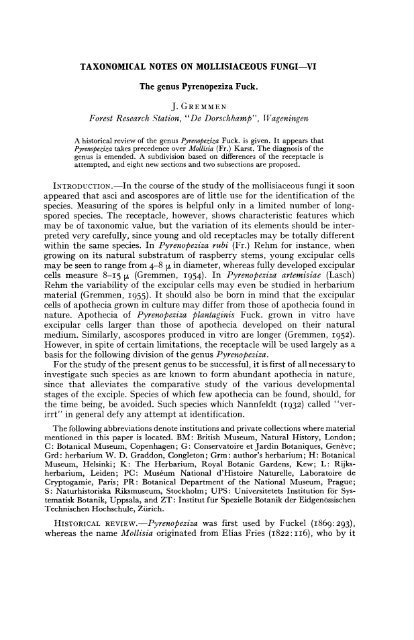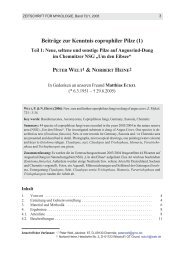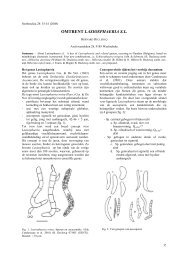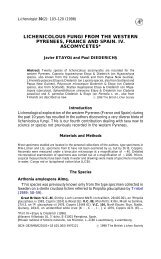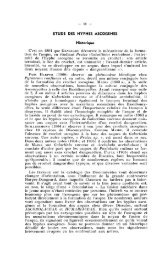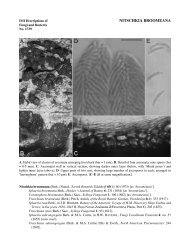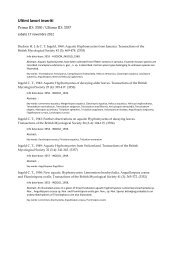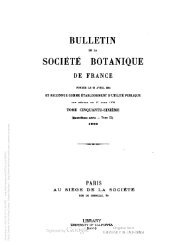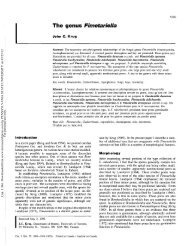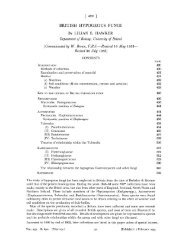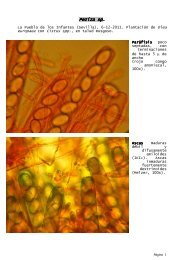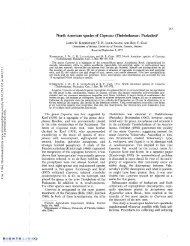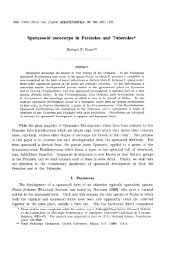The genus Pyrenopeziza Fuck. - ASCOfrance
The genus Pyrenopeziza Fuck. - ASCOfrance
The genus Pyrenopeziza Fuck. - ASCOfrance
You also want an ePaper? Increase the reach of your titles
YUMPU automatically turns print PDFs into web optimized ePapers that Google loves.
TAXONOMICAL NOTES ON MOLLISIACEOUS FUNGI-VI<br />
<strong>The</strong> <strong>genus</strong> <strong>Pyrenopeziza</strong> <strong>Fuck</strong>.<br />
]. GREMMEN<br />
Forest Research Station, "De Dorschkamp", TVageningen<br />
A historical review of the <strong>genus</strong> <strong>Pyrenopeziza</strong> <strong>Fuck</strong>. is given. It appears that<br />
<strong>Pyrenopeziza</strong> takes precedence over Mollisia (Fr.) Karst. <strong>The</strong> diagnosis of the<br />
<strong>genus</strong> is emended. A subdivision based on differences of the receptacle is<br />
attempted, and eight new sections and two subsections are proposed.<br />
INTRODUCTION.-In the course of the study of the mollisiaceous fungi it soon<br />
appeared that asci and ascospores are of little use for the identification of the<br />
species. Measuring of the spores is helpful only in a limited number of longspored<br />
species. <strong>The</strong> receptacle, however, shows characteristic features which<br />
may be of taxonomic value, but the variation of its elements should be interpreted<br />
very carefully, since young and old receptacles may be totally different<br />
within the same species. In <strong>Pyrenopeziza</strong> rubi (Fr.) Rehm for instance, when<br />
growing on its natural substratum of raspberry stems, young excipular cells<br />
may be seen to range from 4-8 f1. in diameter, whereas fully developed excipular<br />
cells measure 8-15 f1. (Gremmen, 1954). In <strong>Pyrenopeziza</strong> artemisiae (Lasch)<br />
Rehm the variability of the excipular cells may even be studied in herbarium<br />
material (Gremmen, 1955). It should also be born in mind that the excipular<br />
cells of apothecia grown in culture may differ from those of apothecia found in<br />
nature. Apothecia of <strong>Pyrenopeziza</strong> plantaginis <strong>Fuck</strong>. grown in vitro have<br />
excipular cells larger than those of apothecia developed on their natural<br />
medium. Similarly, ascospores produced in vitro are longer (Gremmen, 1952).<br />
However, in spite of certain limitations, the receptacle will be used largely as a<br />
basis for the following division of the <strong>genus</strong> <strong>Pyrenopeziza</strong>.<br />
For the study of the present <strong>genus</strong> to be successful, it is first of all necessary to<br />
investigate such species as are known to form abundant apothecia in nature,<br />
since that alleviates the comparative study of the various developmental<br />
stages of the exciple. Species of which few apothecia can be found, should, for<br />
the time being, be avoided. Such species which Nannfeldt (1932) called "verirrt"<br />
in general defy any attempt at identification.<br />
<strong>The</strong> following abbreviations denote institutions and private collections where material<br />
mentioned in this paper is located. BM: British Museum, Natural History, London;<br />
C: Botanical Museum, Copenhagen; G: Conservatoire et Jardin Botaniques, Geneve;<br />
Grd: herbarium W. D. Graddon, Congleton; Grm: author's herbarium; H: Botanical<br />
Museum, Helsinki; K: <strong>The</strong> Herbarium, Royal Botanic Gardens, Kew; L: Rijksherbarium,<br />
Leiden; PC: Museum National d'Histoire Naturelle, Laboratoire de<br />
Cryptogamie, Paris; PR: Botanical Department of the National Museum, Prague;<br />
S: Naturhistoriska Riksmuseum, Stockholm; UPS: Universitetets Institution for Systematisk<br />
Botanik, Uppsala, and ZT: Institut fur Spezielle Botanik der Eidgenossischen<br />
Technischen Hochschule, Zurich.<br />
HISTORICAL REVIEw.-<strong>Pyrenopeziza</strong> was first used by <strong>Fuck</strong>el (1869: 293),<br />
whereas the name Mollisia originated from Elias Fries (1822: 116), who by it
FUNGUS [JAARG. 28 No. 1-4<br />
indicated a tribus of his <strong>genus</strong> Peziza. This tribus was raised to generic rank<br />
by P. A. Karsten (1871: IS), and two sections were distinguished, viz. "Sect. 1.<br />
Apothecia subiculo nullo vel minus distincto insidentia" and "Sect. n.<br />
Apothecia subiculo distincto subtomentoso insidentia Tapesia Fr. p.pr."<br />
Phillips (1887) regarded Mollisia sensu Fr. as a good <strong>genus</strong>, dividing it in the<br />
subgenera Niptera <strong>Fuck</strong>., <strong>Pyrenopeziza</strong> <strong>Fuck</strong>., Dilutella Phill., Mollisiella Phill.,<br />
Hysteropeziza Rabh., Pseudopeziza <strong>Fuck</strong>., and Peristomialis (without author's<br />
name). In part this scheme is based on the apothecial structure, e.g. Niptera<br />
being characterized by "texture rather firm; cups plane" and <strong>Pyrenopeziza</strong> by<br />
"texture soft; cups globose (mostly black) ," but on the whole the <strong>genus</strong> is very<br />
heterogeneous.<br />
Rehm (r896) recognized in his Mollisieae the group Eumollisieae with<br />
"Apothecien von Anfang an sitzend" and the Pyrenopezizeae characterized by<br />
"Apothecien zuerst in die oberen Zellschichten eingesenkt, durch dieselben<br />
hervorbrechend und dann sitzend." <strong>The</strong> Eumollisieae are split up into (a) genera<br />
without a subiculum, comprising Mollisia Fr., Niptera Fr., Belonidium Mont. &<br />
Dur., and Belonopsis Sacc., and (b) genera with a subiculum such as Tapesia<br />
Pers. and Trichobelonium Sacc. <strong>The</strong> Pyrenopezizeae comprise the Pseudopezizeae<br />
with the genera Pseudopeziza <strong>Fuck</strong>., and Fabraea Sacc., and the Eupyrenopezizeae<br />
with <strong>Pyrenopeziza</strong> <strong>Fuck</strong>., Pirottaea Sacc. & Speg., Beloniella Sacc.,<br />
and Velutaria <strong>Fuck</strong>.<br />
Boudier (r907) mentioned in his family Mollisiacees the following genera:<br />
<strong>Pyrenopeziza</strong> <strong>Fuck</strong>., Ephelina Sacc., Pirottaea Sacc., Coronellaria Karst.,<br />
Mollisia Fr., Tapesia Pers., Niptera Fr., Mollisiella Boud., and Spilopodia Boud.<br />
He characterized Mollisia as follows: "L'aspect general aplati, plus Hale, des<br />
receptacles qui sont toujours sessiles, ... " and <strong>Pyrenopeziza</strong>: "Les receptacles<br />
sont generalement noirs exterieurement avec la marge plus blanche." According<br />
to Boudier the paraphyses in M ollisia are filled with an oily protoplasm, lacking<br />
in <strong>Pyrenopeziza</strong>.<br />
In r9I2 Rehm revised the Pyrenopezizeae and the <strong>genus</strong> <strong>Pyrenopeziza</strong> was<br />
again discussed in detail.<br />
Nannfeldt (1932) recognized two subfamilies in his Mollisioideae, viz. the<br />
Mollisieae and the Pyrenopezizeae. <strong>The</strong> first category dealt with the species<br />
having the "Apothecien ganz oberfHichlich oder nur mit zapfen-formiger Basis<br />
im Substrat eingesenkt," those of the second group having the "Apothecien im<br />
Substrat eingesenkt, hervorbrechend." In the former are found the genera<br />
Haglundia Nannf., Belonium Sacc., Coronellaria Karst., Tapesia <strong>Fuck</strong>., Trichobelonium<br />
Rehm, Motlisia (Fr.) Karst., and Belonopsis Rehm; in the latter<br />
Pirottaea <strong>Fuck</strong>. and Hysteropezizella v. Hohn.<br />
<strong>The</strong> present author already demonstrated that it is hardly possible to delimit<br />
the <strong>genus</strong> <strong>Pyrenopeziza</strong> <strong>Fuck</strong>. from Mollisia (Fr.) Karst. merely on the basis of<br />
its erumpent behaviour during development. Nannfeldt occasionally arrived<br />
at the same conclusion (r932: 123,156), but probably maintained the separation<br />
for practical purposes. Gremmen (1954) united both genera, assuming Mollisia<br />
Fr. to be the correct name. It appears, however, that <strong>Pyrenopeziza</strong> <strong>Fuck</strong>. was<br />
published two years prior to Mollisia (Fr.) Karst., so the former takes precedence.<br />
Some corrections and additions to the diagnosis previously published<br />
appear necessary.
Nov. 1958J J. GREMMEN: On mollisiaceous fungi-VI<br />
PYRENOPEZIZA <strong>Fuck</strong>. em. Gremmen<br />
<strong>Pyrenopeziza</strong> <strong>Fuck</strong>., Symb. myc. 293. 1869.<br />
Peziza ser. III Phialea Trib. XI Mollisia Fr., Syst. myc. 2: 116. 1822. - Mollisia (Fr.) Karst.,<br />
Myc. fenn. 1: IS. 1871. - Mollisia Fr. sensu Gremmen in Fungus 24:2. 1954.<br />
Apothecia scattered or gregarious, small, ceraceous, sessile, shortly stipitate or broadly<br />
based, erumpent or superficial from the beginning, cupuliform to disciform. Receptacle<br />
even, verrucose, fimbriate or hairy. Ectal excipulum consisting of textura globulosa,<br />
i.e. of roundish, oblong or polyhedral cells which may be variously coloured or colourless;<br />
marginally with or without elongate or club-shaped, coloured or colourless cells.<br />
Hymenium variously coloured. Hypothecium colourless, undefined. Asci minute, clavate<br />
or cylindrical. Ascospores 4 or 8 per ascus, I-celled, or 2- or 4-septate, bacilliform,<br />
cylindrical, ovoid, comma-shaped or acicular. Paraphyses filiform or lanceolate,<br />
colourless. Type species: Peziza chailletii Pers. (vide Nannfeldt, 1932: 137).<br />
Already Nannfeldt distinguished certain groups in the <strong>genus</strong> <strong>Pyrenopeziza</strong>,<br />
one of which is " ... u.a. charakterisiert durch verhaltnismassig grosse, mehr<br />
oder weniger niedergedriickt ellipsoidische Apothecien, ..." A number of species<br />
were considered to belong to this group. Another group" ... bildet eine Anzahl<br />
von Arten, die samtlich auf vorjahrigen Stengeln wachsen und deren Apothecien<br />
mit breiter Basis ihren Holzzylindern aufsitzen."<br />
As appears from the following it is possible to distinguish eight sections which<br />
are mainly based on differences of the colour and structure of the receptacle.<br />
KEY TO THE SECTIONS<br />
I a. Paraphyses filiform<br />
2a. Receptacle even, glabrous<br />
3a. Receptacle dark brown or red-brown<br />
4a. Receptacle sessile on a hypostroma<br />
4b. Receptacle without a hypostroma<br />
3b. Receptacle differently coloured<br />
sa. Receptacle olivaceous or greenish<br />
brown<br />
5b. Receptacle melleous or light brown<br />
2b. Receptacle verrucose, fimbriate or hairy<br />
6a. Receptacle verrucose<br />
7a. Ascospores bacilliform<br />
7b. Ascospores ovoid<br />
6b. Receptacle with appendages<br />
8a. Receptacle fimb riate<br />
8b. Receptacle hairy<br />
Ib. Paraphyses lanceolate . . . . . . .<br />
Sectio 1. PYRENOPEZIZA<br />
· Sectio 2. Hypostromatina<br />
· Sectio 3. Astromatina<br />
· Sectio 4. Elaiodiscina<br />
· Sectio 5. Melipeziza<br />
· Sectio I. <strong>Pyrenopeziza</strong>, subsectio a.<br />
· Sectio I. <strong>Pyrenopeziza</strong>, subsectio b.<br />
· Sectio 6. Fimbriaria<br />
· Sectio 7. Trichantina<br />
· Sectio 8. Hemipirottaea<br />
Apothecia erumpentia, sessilia vel basi stipite fusca. Receptaculum verrucosum. In caulibus<br />
anni praeteriti emortuis. Sectionis species typica: P. chailletii (Pers.) <strong>Fuck</strong>.<br />
Apothecia erumpent, with or without dark brown base submerged in host. Receptacle<br />
verrucose, owing to presence of groups of protruding cells. Inhabiting last year's sterns.<br />
Type species: P. chailletii (Pers.) <strong>Fuck</strong>.<br />
<strong>The</strong> section is divided in two subsections.<br />
39
40 FUNGUS [JAARG. 28 No. r-4<br />
Sabsectio a. Bacillares Gremmen, subsect. novo<br />
Ascosporae bacilliformes, unicellulares vel pluricellulares.<br />
Ascospores bacillifonn, 1- or more-celled.<br />
1. PYRENOPEZIZA CHAILLETII (Pers.) <strong>Fuck</strong>., Symb. myc. 294. 1869.<br />
Peziza chailletii Pers., Myc. eur. 1: 288. 1822 (basionym).<br />
Mat.erial: <strong>Pyrenopeziza</strong> chailletii <strong>Fuck</strong>. (G).<br />
Host: Chaerophyllum aureum.<br />
2. PYRENOPEZIZA POTENTILLAE (Rostr.) Nannf. in Svensk bot. Tidskr. 22: 136.<br />
1928.<br />
Trochilapotentillae Rostr. in Medd. om Gronl. 3: 54°.1888 (basionym).<br />
Material: Trochila potentillae Rostr., type (C).<br />
Host: Potentilla nivea.<br />
3. PYRENOPEZIZA THALICTRI (Peck) Sacc., Syll. Disc. 360. 1889.<br />
Peziza thalictri Peck in Ann. Rep. N.Y. State Mus. 29: 55. 1878 (basionym). - <strong>Pyrenopeziza</strong><br />
osiliensis Vgr. in Bot. Not. 40. 1900. - Beloniella osiliensis (Vgr.) Rehm in Ber. bayr. bot. Ges. 13:<br />
18I. 1912.<br />
Material: no. 517, <strong>Pyrenopeziza</strong> thalictri (Grd).<br />
Host: Thalictrum spec.<br />
4. PYRENOPEZIZA PYRENOCARPOIDES Rehm in Ber. bayr. bot. Ges. 13: 175·<br />
1912.<br />
Mollisia pyrenocarpoides (Rehm) Gremmen in Fungus 25: 9. 1955.<br />
Material: <strong>Pyrenopeziza</strong> pyrenocarpoides Rehm (S).<br />
Host: Cirsium spec.<br />
5. <strong>Pyrenopeziza</strong> buniadis (Nannf.) ex Gremmen, comb. novo<br />
Mollisia buniadis Nannf. spec. novo inedit. (basionym).<br />
Material: Flora suec. 1913, Mollisia bumiadis Nannf., Uppsala, Slottsbacken,<br />
11.6. 1925, leg. ]. A. Nannfeldt, type (UPS).<br />
Host: Bunias orientalis.<br />
Apothecia 400-500 ft diam., basi 80 ft lata. Receptaculum verrucosum, melleum, e textura<br />
globulosa. Cellulae excipuli 7-10ft diam. Margo cellulis minutis formata. Asci 38-50 X 5·5 ft·<br />
Ascosporae 9.5-10.5 X 2 ft' unicellulares, incoloratae. Paraphyses filiformes, incoloratae,<br />
guttulatae.<br />
Apothecia 400-500 ft across, with 80 ft broad base. Receptacle consisting of textura<br />
globulosa, honey-brown, verrucose owing to presence ofprotruding cells. Excipular cells<br />
7-10 ft in diameter, marginally with short cell-excrescences. Asci 38-50 X 5·5 ft. Ascospores<br />
9.5-10.5 X 2 ft, colourless, 1-celled. Paraphyses colourless, filiform, filled with<br />
numerous, minute guttulae.<br />
6. PYRENOPEZIZA LYCHNIDIS (Sacc.) Rehm in Krypt. Fl. 3: 1265. 1896.<br />
<strong>Pyrenopeziza</strong> sphaerioides (Pers.) <strong>Fuck</strong>. f. lychnidis Sacc., Syll. Disc. 365. 1889.<br />
Material: Rabenh.-Pazschke, Fgi. eur. & extraeur. 4173, <strong>Pyrenopeziza</strong><br />
lychnidis Sacc. (L).<br />
Host: Lychnis spec.<br />
7· PYRENOPEZIZA LAVATERAE E. Muller in Sydowia 9: 239· 1955·<br />
Material: Fgi. Pakistan 4387, <strong>Pyrenopeziza</strong> lavaterae E. Mull., type (ZT).<br />
Host: Lavatera spec.
Nov. I958J J. GREMMEN: On mollisiaceous fungi-VI<br />
Subsectio b. Ovoideae Gremmen, subsect. novo<br />
Ascosporae ovoideae vel formam commatis aemulantes, unicellulares.<br />
Ascospores ovoid or comma-shaped, I-celled.<br />
8. PYRENOPEZIZA NIGRELLA <strong>Fuck</strong>, Symb. myc. Nachtr. 3: 30. I87!.<br />
Material: <strong>Pyrenopeziza</strong> nigrella <strong>Fuck</strong> (G).<br />
Host: Succisa pratensis.<br />
9. PYRENOPEZIZA LYTHRI Fautr. in Rev. myc. 14: 3. 1892.<br />
Material: Rabenh.-Pazschke, Fgi. eur. & extraeur. 4470, PYl'enopeziza<br />
lycopodis f. lythri Rehm (L).<br />
Host: Lythrum salicaria.<br />
10. PYRENOPEZIZA UNI (Rostr.) Petr. & Syd. in Ann. myc. 22: 356. 1924.<br />
Laestadia lini Rostr. in Bot. Tidsskr. 28: 217.1907 (basionym).<br />
Material: <strong>Pyrenopeziza</strong> lini (Rostr.) Petr. & Syd. (ZT).<br />
Host: Linum viscosum.<br />
I!. PYRENOPEZIZA BUBAKII Klika in Ann. myc. 24: 136. 1926.<br />
Material: Krypt. exs.
42 FUNGUS [JAARG. 28 No. 1-4<br />
14. <strong>Pyrenopeziza</strong> revincta (Karst.) Gremmen, comb. novo<br />
Peziza revincta Karst., Mon. Pez. 157. 1869 (basionym). - Mollisia revincta (Karst.) Rehm<br />
in Krypt. Fl. 3: 1264. 1896.<br />
Material: Peziza revincta Karst., type (H).<br />
Host: Rubus, Vlmaria, Epilobium, and various Compositae.<br />
IS. <strong>Pyrenopeziza</strong> benesuada (Tu!.) Gremmen, comb. novo<br />
Peziza benesuada Tul. in Bot. Zeit. 11: 55. 1853 (basionym). - Mollisia benesuada (Tul.)<br />
Phill., Man. Brit. Disc. 174. 1887.<br />
. Material: Flora suec. 9452, Mollisia cf. benesuada (UPS).<br />
Host: Alnus spec.<br />
16. <strong>Pyrenopeziza</strong> adenostylidis (Rehm) Gremmen, cumb. novo<br />
Mollisia adenostylidis Rehm in Krypt. Fl. 3: 526, 1896 (basionym).<br />
Material: Rehm, Ascom. 49, Mollisia adenostylidis Rehm (S).<br />
Host: Adenostyles spec.<br />
17. <strong>Pyrenopeziza</strong> arundinacea (DC.) Gremmen, comb. novo<br />
Xyloma arundinacea DC., Fl. France 6: 162. 1815 (basionym). - Mollisia arundinacea (DC.)<br />
Phill., Man. Brit. Disc. 177. 1887.<br />
Material: Rabenh. 423, Peziza cinerea Batsch (L).<br />
Host: Phragmites communis.<br />
Sectio 4. Elaiodiscina Gremmen, sect. novo<br />
Receptaculum olivaceum vel virido-fuscum. In caulibus anni praeteriti emortuis. Sectionis<br />
species typica: P. carduorum Rehm.<br />
Receptacle olivaceous or brownish green. Inhabiting last year's stems. Type species:<br />
P. carduorum Rehm.<br />
18. PYRENOPEZIZA CARDUORUM Rehm in Winter, Diag. u. Notiz. zu Rehm's<br />
Ascom. 562. 1872.<br />
Niptera carduorum (Rehm) Winter in Krypt. Fl. 3: 555. 1896. - Ephelina carduorum (Rehm)<br />
Rehm in Ber. bayr. bot. Ges. 13: 183. 1912. - Mollisia carduorum (Rehm) Gremmen in Fungus<br />
25: 5· 1955·<br />
Material: Rehm, Ascom. 68, <strong>Pyrenopeziza</strong> carduorum Rehm, type (S).<br />
Host: Cirsium spec.<br />
19. <strong>Pyrenopeziza</strong> pastinacae (Nann£.) Gremmen, comb. novo<br />
Mollisia pastinacae Nannf. in Nova Acta Reg. Soc. Sci. Ups. ser. 4. 8 (2): 127. 1932 (basionym).<br />
Material: Flora suec. 1906, Mollisia pastinacae Nannf., isotype (UPS).<br />
Host: Pastinaca, Anthriscus, Bidens, Cirsium, Heracleum, Angelica.<br />
20. PYRENOPEZIZA URTICICOLA (Phill.) Boud., Disc. d'Eur. 135. 1907.<br />
Mollisia urticicola Phill., Man. Brit. Disc. 177. 1887 (basionym).<br />
Material: no. 1109, Mollisia urticicola Phill., teste ]. A. Nannfeldt (Grd).<br />
Host: Vrtica dioica.<br />
21. <strong>Pyrenopeziza</strong> depressuloides (Gremmen) Gremmen, comb. novo<br />
Mollisia depressuloides Gremmen in Fungus 25: 9. 1955 (basionym).
44 FUNGUS [JAARG. 28 No. 1-4<br />
29. PYRENOPEZIZA RUBI (Fr.) Rehm in Krypt. Fl. 3: 611. 1896.<br />
Excipula rubi.Fr., Syst. myc. 2: 190. "1-822 (basionym). - Mollisia rubi (Fr.) Karst., Rev·<br />
Mon. 136. 1885.<br />
Material: Rabenh., Herb. myc. 2, 3°5, Peziza phacidioides Fr. (L).<br />
Host: Rubus spec.<br />
30. PYRENOPEZIZA MILLEGRANA Boud., Disc. d'Eur. 133. 1907.<br />
Mollisia millegrana (Boud.) Nannf. in Nova Acta Reg. Soc. Sci. Ups. ser. 4. 8 (2): 127. 1932.<br />
Material: Flora suec. 4315, Mollisia millegrana (Boud.) Nannf. (UPS).<br />
Host: Ulmaria.<br />
31. PYRENOPEZIZA ARCTII (PhiU.) Nannf. in Nova Acta Reg. Soc. Sci. Ups. ser.<br />
4. 8 (2): 142. 1932.<br />
Peziza arctii Phill. in Proc. Bristol Nat. Soc. N.S. 4: 58. 1883 (basionym). - Mollisia arctii<br />
(Philt) Phill., Man. Brit. Disc. 183. 1887. - Belonium arctii (Phill.) Sacc., Syll. Disc. 495. 1889.<br />
- Belonidium arctii (Phill.) Massee, Brit. Fung. Fl. 4: 225. 1895.<br />
Material: Peziza arctii Phill., type (BM).<br />
Host: Arctium spec.<br />
32. PYRENOPEZIZA EBULI (Fr.) Sacc., Syll. Disc. 360. 1889.<br />
Peziza atrata var. ebuli Fr., Syst. myc. 2: 148. 1822 (basionym). - Mollisia ebuli (Fr.) Karst.,<br />
Myc. fenn. 1: 202. 1871.<br />
Material: Rehm, Ascom. 656-b, Mollisia ebuli (Fr.) Karst. (S).<br />
Host: Sambucus ebulus.<br />
33. PYRENOPEZIZA PLANTAGINIS <strong>Fuck</strong>., Symb. myc. 294. 1870.<br />
Mollisia plantaginis (<strong>Fuck</strong>.) Phill., Man. Brit. Disc. 183. 1887. - Peziza atrata var.foliicola<br />
Desm. in Ann. Sci. Nat. ser. 2, Bot. 368-369.1843.<br />
Material: Desm. Crypt. Fr. Ser. I, 1313, Peziza atrata var. joliicola Desm.<br />
(K).<br />
Host: Plantago lanceolata.<br />
34. <strong>Pyrenopeziza</strong> pulveracea (<strong>Fuck</strong>.) Gremmen, comb. novo<br />
Peziza pulveracea <strong>Fuck</strong>., Symb. myc. 297. 1870 (basionym). - Mollisia pulveracea (<strong>Fuck</strong>.)<br />
Rehm in Krypt. Ft 3: 532. 1896.<br />
Material: Fgi. rhen. 2191, Peziza pulveracea <strong>Fuck</strong>., type (G).<br />
Host: Ulmaria.<br />
35. <strong>Pyrenopeziza</strong> polygoni (Lasch) Gremmen, comb. novo<br />
Peziza polygoni Lasch in Klotzsch, Herb. vivo myc., in Rabenh., Herb. myc. 1842 (basionym).<br />
- Mollisiapolygoni (Lasch) Rehm in Krypt. Fl. 3: 527.1896.<br />
Material: Rehm, Ascom. 70, Niptera polygcni Rehm (L).<br />
Host: Polygonum amphibium.<br />
36. PYRENOPEZIZA PETIOLARIS (A. & S. ex Fr.) Nannf. in Nova Acta Reg. Soc.<br />
Sci. Ups. ser. 4. 8 (2): 158. 1932.<br />
Hysterium petiolare A. & S., Consp. Fung. Nisk. 59. 1805; ex Fr., Syst. myc 2: 593. 1823<br />
(basionym). - Trochila petiolaris (A. & S. ex Fr.) Rehm in Krypt. Fl. 3: 132. 1896. - Mollisia<br />
petiolaris (A. & S. ex Fr.) Gremmen in Fungus 24: 9. 1954.<br />
Material: no. 9700, Mollisia petiolaris (A. & S. ex Fr.) Gremmen (L).<br />
Host: Acer spec.
FUNGUS [JAARG. 28 No. 1-4<br />
Receptacle marginally as well as laterally provided with brown, septate hairs.<br />
Inhabiting last year's stems. Type species: P. escharodes (B. & Br.) Rehm.<br />
This group forms a transition to the <strong>genus</strong> T apesia <strong>Fuck</strong>.<br />
44. PYRENOPEZIZA ESCHARODES (B. & Br.) Rehm in Krypt. Fl. 3: 612. 1896.<br />
Peziza escharodes B. & Br. in Ann. Mag. nat. Hist. ser. 4. 7: 433. 1871 (basionym). <br />
Lachnella escharodes (B. & Br.) Phill., Man. Brit. Disc. 262. 1887. - Mollisia escharodes (B. & Br.)<br />
Gremmen in Fungus 24: 5. 1954.<br />
Material: Peziza escharodes B. & Br., type (BM).<br />
Host: Rubus spec.<br />
Sectio 8. Hemipirottaea Gremmen, sect. novo<br />
Apothecia paraphysibus lanceolatis instructa. In caulibus anni praeteriti emortuis. Sectionis<br />
species typica: P. lanceolata (Gremmen) Gremmen.<br />
Apothecia with characteristic lanceolate paraphyses. Inhabiting last year's stems.<br />
Type species: P. lanceolata (Gremmen) Gremmen.<br />
This section is intermediate between the section Astromatina and the <strong>genus</strong><br />
Pirottaea Sacc.<br />
45. <strong>Pyrenopeziza</strong> lanceolata (Gremmen) Gremmen, comb. novo<br />
Mollisia lanceolata Gremmen in Fungus 26: 35. 1956 (basionym).<br />
Material: no. 690, Mollisia lanceolata Gremmen, type (Grm).<br />
Host: Ulmaria.<br />
ACKNOWLEDGEMENT.-Dr R. A. Maas .Geesteranus (Leiden) critically<br />
revised the manuscript for which I am very thankful.<br />
REFERENCES<br />
BOUDlER, EM. 1907. Histoire et Classification des Discomyce:tes d'Europe. Paris.<br />
FRIES, E. 1822-1823. Systema mycologicum 2. Lundae.<br />
FUCKEL, L. (1869) 1870. Symbolae mycologicae. Wiesbaden.<br />
GREMMEN, j. 1952. Het <strong>genus</strong> <strong>Pyrenopeziza</strong>. Levenswijze en cultuur van <strong>Pyrenopeziza</strong> plantaginis<br />
<strong>Fuck</strong>. in Fungus 22: 22-24.<br />
--- 1954. Taxonomical notes on Mollisiaceous fungi-I. A study on some Dutch species<br />
growing on Rubus stems. In Fungus 24: 1-8.<br />
--- 1955. Taxonomical notes on Mollisiaceous fungi-H. Some caulicolous Mollisia species<br />
inhabiting various hosts, mainly Compositae. In Fungus 25: 1-12.<br />
KARSTEN, P. A. 1871. Mycologia fennica, Pars I. Discomycetes. In Bidr. Kann. Fin!. Nat. Folk<br />
19.<br />
NANNFELDT,j. A. 1932. Studien iiber die Morphologie und Systematik der nicht-lichenisierten<br />
inoperculaten Discomyceten. In Nova Acta Reg. Soc. Sci. Ups. ser. 4. 8 (2).<br />
PHILLlP3, W. 1887. A manual of the British Discomycetes. London.<br />
REHM, H. 1896. Die Pilze Deutschlands, Oesterreichs und der Schweiz. In Rabenhorst's<br />
Kryptogamenflora, ed. 2, 1 (3). Leipzig.<br />
--- 1912. Zur Kenntnis der Discomyceten Deutschlands, Deutsch-Oesterreichs und der<br />
Schweiz. In Ber. bayr. bot. Ges. 13: 102-206.


